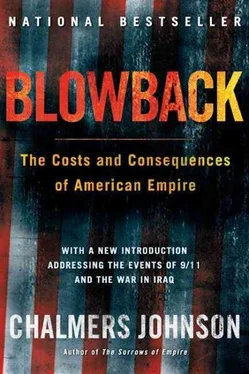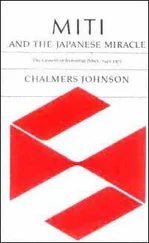Chalmers Johnson - Blowback, Second Edition - The Costs and Consequences of American Empire
Здесь есть возможность читать онлайн «Chalmers Johnson - Blowback, Second Edition - The Costs and Consequences of American Empire» весь текст электронной книги совершенно бесплатно (целиком полную версию без сокращений). В некоторых случаях можно слушать аудио, скачать через торрент в формате fb2 и присутствует краткое содержание. Год выпуска: 0101, ISBN: 0101, Издательство: Macmillan, Жанр: Старинная литература, на английском языке. Описание произведения, (предисловие) а так же отзывы посетителей доступны на портале библиотеки ЛибКат.
- Название:Blowback, Second Edition: The Costs and Consequences of American Empire
- Автор:
- Издательство:Macmillan
- Жанр:
- Год:0101
- ISBN:9780805075595
- Рейтинг книги:5 / 5. Голосов: 1
-
Избранное:Добавить в избранное
- Отзывы:
-
Ваша оценка:
- 100
- 1
- 2
- 3
- 4
- 5
Blowback, Second Edition: The Costs and Consequences of American Empire: краткое содержание, описание и аннотация
Предлагаем к чтению аннотацию, описание, краткое содержание или предисловие (зависит от того, что написал сам автор книги «Blowback, Second Edition: The Costs and Consequences of American Empire»). Если вы не нашли необходимую информацию о книге — напишите в комментариях, мы постараемся отыскать её.
Blowback, Second Edition: The Costs and Consequences of American Empire — читать онлайн бесплатно полную книгу (весь текст) целиком
Ниже представлен текст книги, разбитый по страницам. Система сохранения места последней прочитанной страницы, позволяет с удобством читать онлайн бесплатно книгу «Blowback, Second Edition: The Costs and Consequences of American Empire», без необходимости каждый раз заново искать на чём Вы остановились. Поставьте закладку, и сможете в любой момент перейти на страницу, на которой закончили чтение.
Интервал:
Закладка:
As the histories of previous empires demonstrate, imperial overstretch can be a long-drawn-out process if all sides are careful to avoid confrontation (the Russian and Ottoman empires come to mind). But such hegemonic policies applied to China are likely to precipitate a crisis. China is the world’s most populous country and has recently achieved an economy that promises to provide it with commensurate wealth and power. It is also an old civilization, whose humbling by foreign imperialists over the past two centuries led to the most sweeping and complex of all the modern revolutions. Its leaders are still working out whether they should seek parity on a global stage as defined by Western conceptions of international relations or try to re-create an older Sinocentric world of tributary states that existed before the arrival of the European imperialists, or perhaps some amalgam of the two.
In any case, China owes no obeisance to the United States. From 1950 to 1953, at great cost to itself, it fought the American military to a stalemate in Korea. A new policy of containment toward China once again implies the possibility of war, just as it did during the Cold War vis-à-vis the former USSR. The balance of nuclear weapons prevented that war, but this may not work in the case of China, where great asymmetries in manpower between China and any single external power or alliance will always exist. China has the capacity to deter an American use of nuclear weapons by threatening retaliation against U.S. cities, and the United States could never mobilize a large enough army to defeat China in a land invasion. There is also a much firmer foundation for a Chinese government’s resistance to external threats in Chinese nationalism than there was at the time of the British, French, Russian, or Japanese depredations over the past 150 years. Many Americans do not evaluate Chinese nationalism correctly, thinking it is whipped up by Communist Party propaganda to suit its purposes. But like American nationalism after Pearl Harbor, it is actually rooted in concrete historical experiences of victimization, including Japan’s attempt to establish a protectorate over China in 1915, its creation of a puppet regime in Manchuria in 1931, and its invasion of the whole country in 1937. The Chinese pose no threat to the territory of the United States, but the Americans (and the Japanese) have done so in the past and conceivably still could directly threaten China. A war with China would almost certainly bankrupt the United States, radicalize China, and tear Japan apart.
Military containment of China is a particularly dangerous policy for Japan (as an American ally) to espouse, since its own emergence onto the world stage began a century ago with its invasion and defeat of China in 1895 and its seizure of the island of Taiwan, which it held as a Japanese colony until 1945. Moreover, because Japan’s devastation of China in the 1930s and 1940s was the crucial factor leading China into the civil war from which the Communist Party emerged victorious, politically aware Chinese remain acutely sensitive to any hint of revived Japanese militarism, just as Russians do to any hint of revived German militarism.
According to a Hong Kong wisecrack, China has just had a couple of bad centuries and is back. The question is whether the United States can adjust to the emergence of a new great power in Asia. Will it deal more effectively and less bloodily with China than, say, the former hegemon Great Britain did in the early twentieth century, when it failed to adjust to the emergence of new centers of power in Germany, Japan, and Russia? The current trend of events is not promising.
In 1949, in proclaiming the birth of the Chinese People’s Republic from atop the Gate of Heavenly Peace overlooking the square of the same name, Tiananmen, in Beijing, Mao Zedong announced that finally “China has stood up.” He was wrong. China had only risen to its knees. Of the two great objectives of the Chinese revolution—ending imperialistic interference in China’s domestic affairs and overcoming China’s economic weakness in relation to the developed world—the Chinese Communists proved able to deliver only on the first. The latter had to wait another forty years, until China finally discovered the secret of the enrichment of East Asia—Japanese-style, state-guided capitalism—and began to act on it. Its economy then started to grow at double-digit rates, threatening to alter the global distribution of power. Without question, the most important element in the current phase of Asia’s empowerment has been China’s belated discovery of the market and its consequent candidacy as the second great power in East Asia, perhaps as the superpower of the twenty-first century.
Ever since the industrial revolution, the cardinal source of friction in world politics has been the economic inequality it produced. This inequality allowed the first industrializers to use their new power to colonize or in other ways subjugate and exploit the nonindustrialized areas of the world. Nationalistically awakened elites among these subjugated peoples then sought in various ways to overcome their relative backwardness, to equalize relations with or achieve supremacy over their victimizers.
But how can peripheral societies, even when they achieve national independence, break out of their economic and political dependency? In the view of the prominent political scientist Andrew Janos, history offers examples of two grand strategies for dealing with this issue. 3The first was for dependent or “late-developing” countries to attempt through war and revolution to reconstruct their environments. This strategy required a militarization of society and the use of a mobilized people to attack and transform the environment. The execution of this strategy has taken the forms of aggression and conquest (Nazi Germany, Japan from 1931 to 1945), support for world revolution (Lenin’s and Stalin’s Russia), fomenting “people’s wars” (China and Cuba), aggressive neutralism (India), and other projects aimed at altering an environment in which “advanced” countries exploit “developing” ones.
The second strategy has been, in Janos’s words, a “drive to imitate the technological innovations of the advanced countries.” This strategy has generally been internally oriented. It is best illustrated by Japan’s state-guided industrialization from 1868 to approximately the Great Depression and again from 1949 to the present. It may involve only the state’s use of tariffs to shelter its own economy from the penetrative power of stronger national economies. This was the strategy of the United States during the nineteenth and early twentieth centuries, in accordance with the ideas of Alexander Hamilton and Friedrich List. A version of this strategy also became policy in West Germany after its defeat in World War II. But such a strategy involving state guidance of the economy, cartelization, and the strategic allocation of industrial finance may so come to dominate a social system that development itself becomes the main legitimating and organizing principle of society, replacing or displacing democratic representation, tradition, or any other set of political or cultural principles. When that happens, the ensuing regime can be termed a “developmental state.” 4
Needless to say, in comparing the ways each strategy has been used during the twentieth century, it seems clear that the developmental state has proven far more successful than any attempt to forcibly reconstruct the external world, although it is a tricky strategy to execute and has many hidden consequences. It is critically dependent on a permissive international environment, such as the one the United States enjoyed in the nineteenth century or Japan vis-à-vis the United States after 1952.
These two strategies also define the history of the People’s Republic of China since its birth in 1949. From the time Mao discovered that it would not be easy to duplicate a Stalinist program of development in China—that is, when he discovered that his Great Leap Forward campaign to move the country toward heavy industrialization through extreme levels of collectivization had by 1962 resulted in the deaths by starvation of some thirty million people—he experimented with altering the external environment on the cheap. He tried to militarize (he called it “revolutionize”) his own society and to reconstruct the external world by sponsoring or endorsing “people’s wars.” Even though in Vietnam this approach succeeded in tarnishing the image of the United States as a superpower, it did not really alter the balance of power, and the Vietnamese soon resented Mao’s claims of paternity to a strategy they had embarked on without Chinese help. Mao’s massive domestic upheaval, the “Great Proletarian Cultural Revolution,” which started in 1966 and lasted in one form or another almost a decade, was his revenge against the Communist Party after he lost control of it in the wake of the Great Leap Forward. It further discredited him, and communism, in the eyes of his main supporters; after his death in 1976 and the return to power of the purged Deng Xiaoping in 1978, the country devoted itself to reform and recovery from the Cultural Revolution. China began, in short, to experiment with the second strategy for breaking out of its backwardness.
Читать дальшеИнтервал:
Закладка:
Похожие книги на «Blowback, Second Edition: The Costs and Consequences of American Empire»
Представляем Вашему вниманию похожие книги на «Blowback, Second Edition: The Costs and Consequences of American Empire» списком для выбора. Мы отобрали схожую по названию и смыслу литературу в надежде предоставить читателям больше вариантов отыскать новые, интересные, ещё непрочитанные произведения.
Обсуждение, отзывы о книге «Blowback, Second Edition: The Costs and Consequences of American Empire» и просто собственные мнения читателей. Оставьте ваши комментарии, напишите, что Вы думаете о произведении, его смысле или главных героях. Укажите что конкретно понравилось, а что нет, и почему Вы так считаете.










